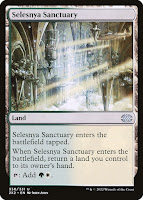 |
| Crop Rotation card art |
I conclude 'land month' with a look at lingo—words players use to describe different types of lands. For most of this article, I will use white/green lands as examples.
Hang around experienced Magic players, and you will hear nicknames for certain types of things. Today our focus is lands. I am indebted to The Gamer's article for their list. They cover more than I do below; I focus on the most common terms.
Basic Lands
I covered these in my first lands post, so I won't re-visit them here. There are five basics (Plains, Island, Swamp, Mountain, Forest) plus Wastes.
Dual Lands
These lands are powerful (and expensive). They enter the battlefield untapped, are two basic land types, and can be tapped for one of two colors of mana. Consider the two cards below: Underground Sea (an Island Swamp) or Savannah (a Forest Plains, shown in modern print format but never available for competitive play in that format). Dual lands were produced only in the first four sets (Alpha, Beta, Unlimited, Revised) and are very hard to get; they will cost you hundreds (or thousands) of dollars.
Can't afford dual lands? Tap lands are for you. Same concept as dual lands, but they enter the battlefield tapped, delaying their use by one turn (a real disadvantage in competitve Magic). There are many variations on this concept, as you can see. Some (Elfhame Palace, Tranquil Expanse) are functional reprints of each other—identical in every way except name. Others (Radiant Grove, Arctic Treeline) add "Forest Plains" to their subtypes, enabling you to 'fetch' them with certain cards (see my first land post). Some are snow lands, artifact lands, or gates. Some allow you to tap them the first turn they are in play, but then they do not untap the next turn, delaying the 'penalty' by one turn. There are other variations, too, but the same principle: you are getting a land that can produce more than one type of mana, but at a 'price:' tapping.
I made this term up; the article I mentioned above would call some of these "Battle," "Bond," or "Reveal" lands. Anyway . . . these lands are those that come into play tapped unless you meet conditions that enable them to come into play untapped. Consider Overgrown Farmland and Razorverge Thicket; these can be played untapped if you have two or more/fewer lands already in play.
Other conditions include number of opponents, number of basic lands you control, types of basic land you control, and types of basic lands you have in your hand.Fetch Lands
These lands enable you to sacrifice them to find other land cards in your deck. Notice that some of them put the fetched land onto the battlefield tapped, and some do not. That can make a huge difference.
Pain & Shock Lands
Pain lands do damage to you whenever you tap them for colored mana. Shock lands, a type of 'conditional tap' land, do damage to you when you play them if you choose to play them untapped (otherwise, they come into play tapped).
Bounce Lands
Lands that make you return another land you control to your hand to play them. They add two mana, though, and can be powerful in certain deck archetypes that benefit from lands hitting the battlefield (like landfall).
Deck Shaping Lands
I'm inventing (and combining) categories again; the article would call these "Cycle" and "Scry" lands. Some lands can be 'cycled' (discarded to draw a card). Some let you scry (look at the top card of your library and put it on the bottom if you wish). Whatever the case, these lands give you access to more desirable cards.
Gain Lands
These come into play tapped, but give you life.
Filter Lands
These let you add two mana (potentially of different colors) for the price of paying one. In the case of Wooded Bastion, you could pay (say) one white mana to add two green. And you could use a red mana and tap Sungrass Prairie to add one white and one green. Since these lands enable you to (effectively) change your mana's color, they are called filter lands.
Final Thoughts
Lands can be so expensive because they are the game's resources, and he who has the most powerful resources has an upper hand. Since many competitive Magic decks are (at least) two colors, getting lands that produce either color of mana is important. If you can afford those that do not tap the turn they come into play, even better. Due to their importance (and the sheer variety of cards in the game), nicknames for certain types of lands have arisen over the years.

















































.jpg)


